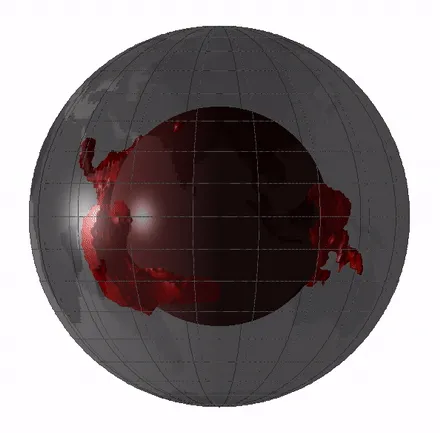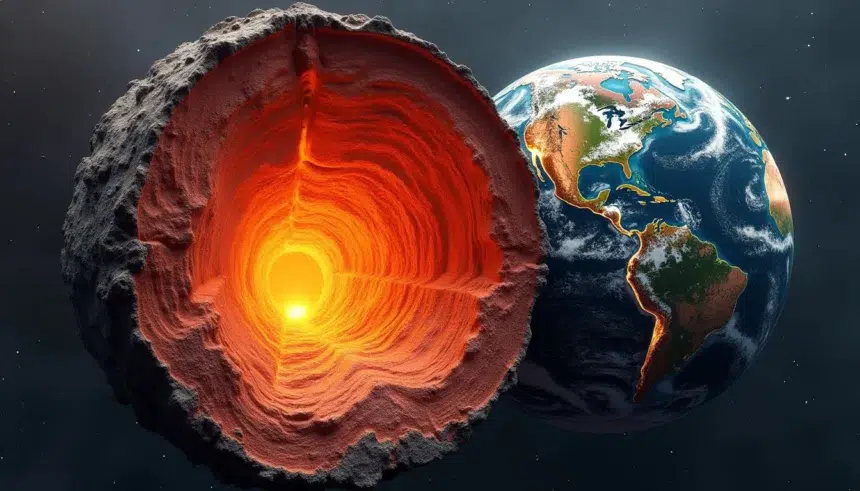Introduction
Far below the Earth’s surface, beyond the reach of sunlight or human exploration, lies the mantle—a mysterious realm of molten rock and immense pressure. This layer, which spans thousands of kilometers between the crust and the core, has long been known as the engine behind volcanic eruptions and the drift of tectonic plates. Scientists thought they had a solid understanding of its workings—until now.
The discovery of two massive mantle structures, each rivaling the size of entire continents, has stunned the scientific community and begun to rewrite geological history. Found lurking beneath Africa and the Pacific Ocean, these hidden giants are changing how we view the Earth’s interior. Let’s journey deep inside our planet to explore what these mantle structures mean and why they matter.
What Exactly Are Mantle Structures?
The Earth’s mantle is a churning sea of semi-molten rock that flows slowly over millions of years, driven by heat from the core. This process, known as mantle convection, powers everything from mountain formation to seismic activity. Scientists have identified various features within this dynamic layer, like plumes and sunken crust slabs. But mantle structures are something bigger—enormous, stable formations that shape the mantle’s behavior on a planetary scale. The two newly discovered mantle structures stand out for their size and unusual density and composition, hinting at a story stretching back billions of years.
Blobs in the Mantle Structure:
These enormous formations, often called “blobs” or “large low-shear-velocity provinces” (LLSVPs), sit in the lower mantle, close to where they meet the outer core. One lurks beneath the African continent, while the other stretches under the Pacific Ocean. Spanning thousands of kilometers across and towering hundreds of kilometers high, these structures are anything but ordinary. They’re made of material that differs from the surrounding mantle—potentially hotter, denser, or chemically unique.

Scientists stumbled upon these giants using seismic imaging, a technique that tracks how earthquake waves move through the Earth. When these waves hit the structures, they slow down significantly, hinting at something unusual. This discovery has sparked curiosity and debate as researchers work to decode the nature of these hidden behemoths.
How They’re Rewriting Geological History
The mantle was a relatively consistent layer for years, with heat and rock moving in predictable cycles. The discovery of these mantle structures flips that idea on its head. Their sheer size and stability suggest they’ve been around for eons—possibly since Earth’s infancy. Some experts propose they’re ancient relics, leftover fragments from the planet’s chaotic formation. Others think they might be piles of oceanic crust swallowed by the mantle over billions of years of subduction. Whatever their origins, these mantle structures are forcing a rethink of how the Earth’s interior has evolved and how it influences surface events like the shifting of tectonic plates or the creation of volcanic hotspots.
Detecting these mantle structures challenges everything we thought we knew about Earth’s interior. Until recently, the mantle was seen as a relatively consistent layer, with heat and rock flowing in predictable patterns through a process called mantle convection. This convection powers the movement of tectonic plates and shapes the planet’s surface. But these massive formations suggest the mantle is far less uniform than once assumed.
Their presence raises big questions. Could they disrupt or guide mantle convection in unexpected ways? Some experts think these structures might anchor tectonic activity, influencing where continents drift or volcanoes erupt. Others propose they’re remnants of Earth’s ancient past—perhaps chunks of primordial rock from the planet’s formation or piles of oceanic crust swallowed up by subduction over billions of years. Whatever their origin, they reveal a mantle with a rich, layered history, reshaping our view of how Earth evolved.
The Science Behind the Discovery
The implications of these mantle giants are staggering. For starters, they suggest the mantle isn’t a single, homogenous mass but a patchwork of distinct regions. This complexity could affect how tectonic plates behave, how heat escapes the Earth’s core, and even how the planet’s magnetic field stays strong—a shield that protects us from solar radiation. This breakthrough comes thanks to a global team of geophysicists and seismologists pushing the boundaries of technology. Using seismic tomography—a method akin to planetary ultrasound—researchers analyze data from countless earthquakes to build 3D maps of the Earth’s interior. These maps show where seismic waves slow or speed up, revealing the mantle’s hidden features.
Beyond seismic data, scientists rely on advanced computer models and lab experiments to simulate the intense heat and pressure of the deep Earth. Recent efforts have also tapped into satellite measurements of Earth’s gravity, offering clues about the structures’ mass and density. Institutions like the University of Maryland and the California Institute of Technology have played key roles in piecing this puzzle together, blending cutting-edge tools with scientific expertise.
There’s also a possible link to volcanic hotspots, like those fueling Hawaii or Iceland. These hotspots sit above the edges of the structures, hinting that the formations might channel heat or magma to the surface. Plus, studying them could unlock clues about Earth’s infancy, shedding light on how our planet formed and changed over its 4.5-billion-year history.
Conclusion:
The discovery of these two giant mantle structures is a game-changer for geology, proving that even the deepest parts of Earth still hold surprises. These subterranean titans are reshaping geological history and opening new frontiers in science. As researchers continue to probe these mysteries with tools like seismic imaging, we will learn more about the Earth’s past and dynamic present.
Unveiled through human ingenuity and advanced science, these formations challenge old ideas and spark new questions about our planet’s inner workings. As research continues, they promise to deepen our grasp of Earth’s past and present, reminding us that the ground beneath our feet is part of a dynamic, ever-evolving story. Stay tuned—there’s much more to learn from these hidden giants.





